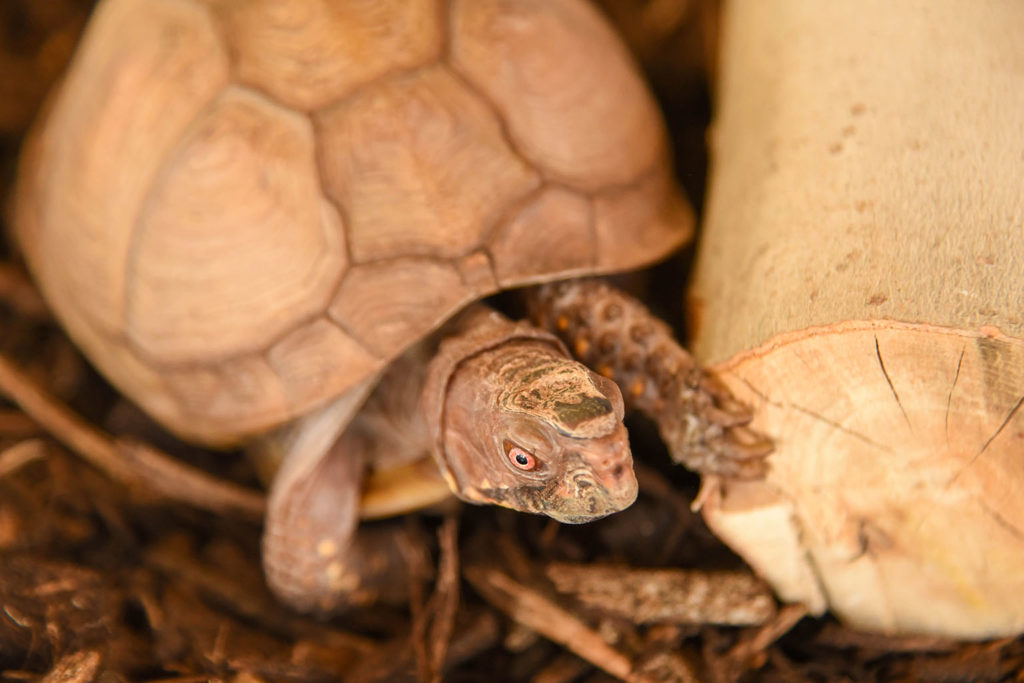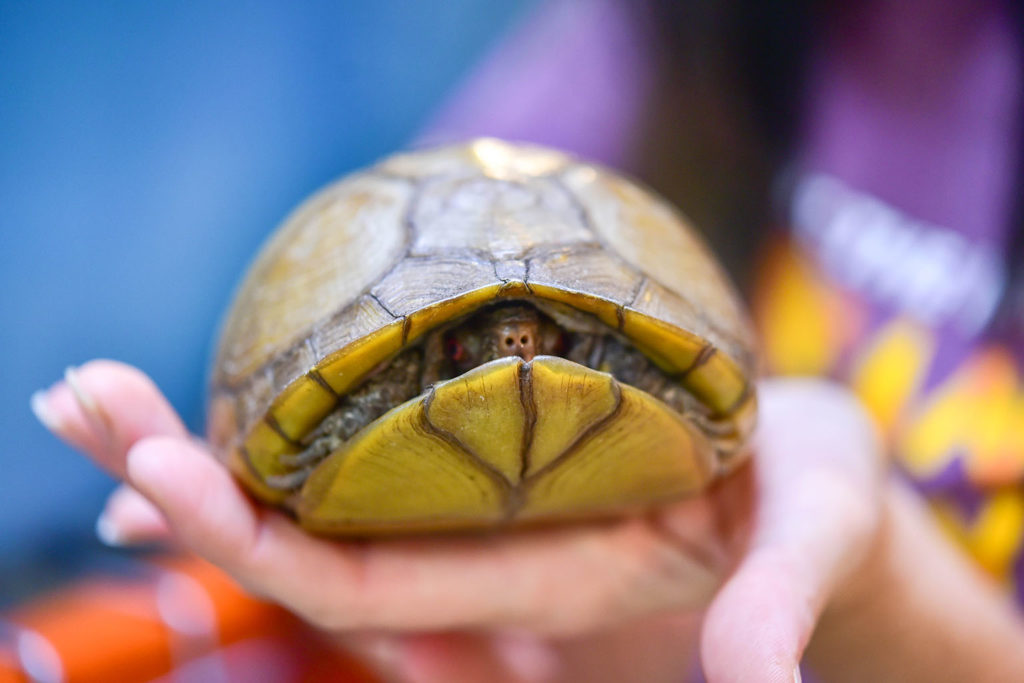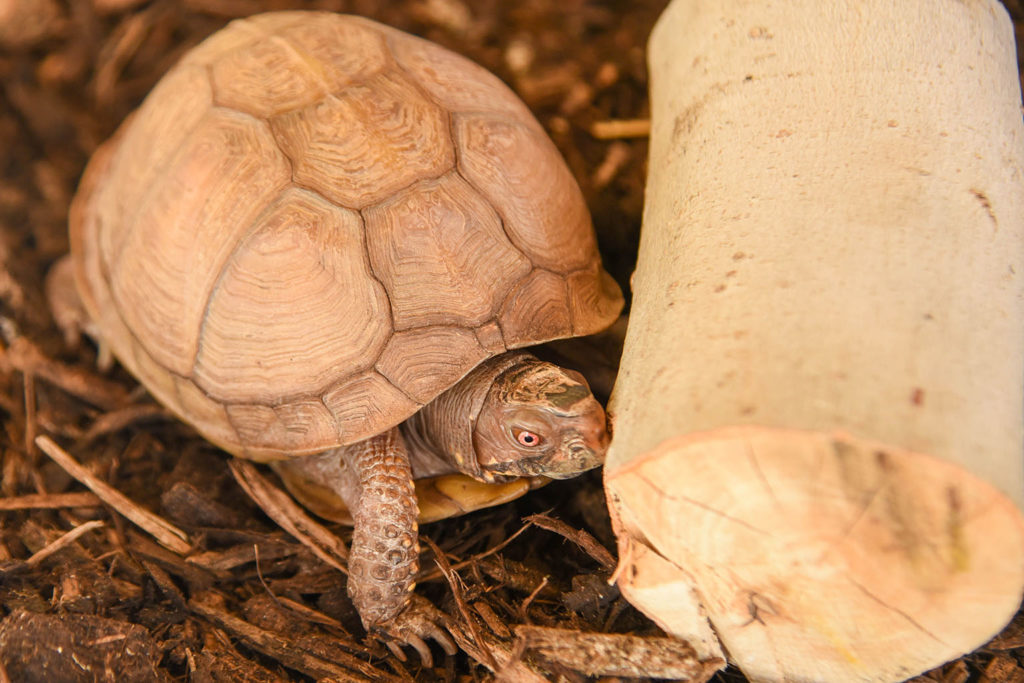Overview
Where I live
There are currently 6 recognized subspecies of Terrapene carolina – 4 native to the United States and 2 native to Mexico. The three-toed box turtle, T. carolina triunguis, is native to the south-central United States, from Missouri and Oklahoma south to Alabama and west into Texas. This turtle needs to live near water and prefers a combination of wooded and grassy habitat.
The Maryland Zoo includes a three-toed box turtle among its Animal Ambassadors, which are introduced to audiences at education programs on and off Zoo grounds. Visitors to the Zoo can also see eastern box turtles – another subspecies of Terrapene carolina – in the Meadow exhibit of the Maryland Wilderness area.
How I live there
Three-toed box turtles are shy and retiring by nature. They live solitary lives, rarely venturing beyond individual territories that are about the size of a football field. They prefer cool, damp weather and are always found near water. They are most likely to be seen just after rain and during spring and early summer, which is when they breed.
Three-toed box turtles are opportunistic omnivores. They feed mainly on insects that they hunt in still, shallow water. However, they also eat plant matter and carrion and prey upon a variety of other small animals, including snails, worms, spiders, frogs, snakes, lizards, and even small mammals.
Like other reptiles, three-toed box turtles are cold-blooded and depend upon the environment to maintain their body temperature. To survive the cold of winter, they dig into leaf litter and soil and go dormant. This state of dormancy is called brumation and is the reptile equivalent of hibernation.
Making my mark
To tell whether you’re really looking at a three-toed box turtle rather than a hybrid or another subspecies of box turtle, check its hind feet. If it has three toes on each hind foot, then it is indeed a three-toed box turtle!
Three-toed box turtles are also the smallest of the T. carolina subspecies and tend to be more drab in color. Their shells are usually a uniform olive-brown, without the patterned bursts of red, yellow, and orange that other box turtles may have.
The three-toed box turtle is the official state reptile of Missouri.
What eats me
Birds of prey, coyotes, and raccoons are likely to prey on the eggs and hatchlings of three-toed box turtles but are less successful taking adults. This is because of the incredibly effective built-in armor that three-toed and other box turtles carry around on their backs. When threatened, three-toed box turtles pull their heads and limbs inside their hinged shells, which clamp shut so tightly that you can’t even pass a blade of grass between the carapace (upper shell) and plastron (lower shell).
The three-toed box turtle, like other turtles, is vulnerable to pressures brought about by people. They are often killed by cars when they try to cross a road. Their habitat is increasingly destroyed or fragmented by development. They also are taken from the wild to be kept as pets, which threatens individual turtles and disrupts the stability of local populations.
Raising young
After breeding, females choose nesting sites, dig a shallow hole with their back legs, deposit 3 to 8 eggs on average, cover them, and then go their own way.
About 3 months later, the baby turtles begin to hatch out. It can take a few days for them to fully emerge from their shells, at which point they are only about 1 inch long! From the moment they hatch, the baby three-toeds are on their own.
Incubation temperature determines the sex of the hatchlings. Lower temperatures favor males while higher temperatures produce females.
Conservation
Populations of all 6 subspecies of Terrapene carolina, including the three-toed box turtle, are in decline. The species is listed as vulnerable by the IUCN, the world’s leading conservation organization. The main causes of decline are habitat destruction and fragmentation, over-collection, and death by vehicle collision. The best things you can do to protect these and other turtles are to leave them wild and watch out for them when driving, especially during the spring or just after rain.
Taxonomy
- Kingdom: Animalia
- Phylum: Chordata
- Subphylum: Vertebrata
- Class: Reptila
- Genera: Terrapene
- Species: carolina triunguis



